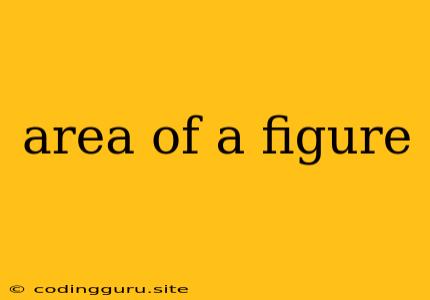Understanding the Area of a Figure: A Guide to Calculating Space
The area of a figure refers to the amount of two-dimensional space a shape occupies. It's a fundamental concept in geometry and has practical applications in various fields, from construction and design to everyday life.
Why is understanding the area of a figure important?
- Construction: Architects and engineers need to calculate the area of a figure to determine the amount of materials needed for building projects.
- Design: Designers use area calculations to create layouts for rooms, furniture, and other objects.
- Everyday life: We use area calculations to figure out how much paint we need for a room, how much carpet to buy for a floor, or how much fabric to use for a sewing project.
How to calculate the area of a figure:
The method for calculating the area of a figure depends on the shape of the figure. Here are some common shapes and their area formulas:
1. Square:
- Formula: Area = side × side
- Example: If a square has a side length of 5 cm, its area is 5 cm × 5 cm = 25 square cm.
2. Rectangle:
- Formula: Area = length × width
- Example: If a rectangle has a length of 10 cm and a width of 5 cm, its area is 10 cm × 5 cm = 50 square cm.
3. Triangle:
- Formula: Area = (1/2) × base × height
- Example: If a triangle has a base of 8 cm and a height of 6 cm, its area is (1/2) × 8 cm × 6 cm = 24 square cm.
4. Circle:
- Formula: Area = π × radius²
- Example: If a circle has a radius of 4 cm, its area is π × 4 cm² ≈ 50.27 square cm. (π is approximately 3.14)
5. Trapezoid:
- Formula: Area = (1/2) × (base1 + base2) × height
- Example: If a trapezoid has bases of 6 cm and 10 cm and a height of 4 cm, its area is (1/2) × (6 cm + 10 cm) × 4 cm = 32 square cm.
6. Parallelogram:
- Formula: Area = base × height
- Example: If a parallelogram has a base of 7 cm and a height of 5 cm, its area is 7 cm × 5 cm = 35 square cm.
7. Irregular Shapes:
For more complex shapes, you may need to divide the shape into smaller, simpler shapes and calculate the area of each figure individually. Then, add the areas of the smaller shapes together to find the total area of the figure.
Tips for calculating the area of a figure:
- Identify the shape: The first step is to determine the type of shape you are working with.
- Use the correct formula: Each shape has a specific formula for calculating its area.
- Pay attention to units: Make sure all measurements are in the same units (e.g., centimeters, inches).
- Use a calculator: For calculations involving decimals or π, a calculator can be helpful.
Example:
Let's say we want to calculate the area of a figure that is made up of a rectangle and a triangle.
- The rectangle has a length of 10 cm and a width of 5 cm.
- The triangle has a base of 5 cm and a height of 4 cm.
To find the total area of the figure, we need to calculate the area of each shape and add them together:
- Area of the rectangle: 10 cm × 5 cm = 50 square cm
- Area of the triangle: (1/2) × 5 cm × 4 cm = 10 square cm
- Total area: 50 square cm + 10 square cm = 60 square cm
Conclusion:
Understanding the area of a figure is essential for various applications, from construction to design and everyday life. By using the appropriate formulas and following some simple tips, you can calculate the area of any figure with ease. Remember to identify the shape, use the correct formula, and pay attention to units for accurate results.
